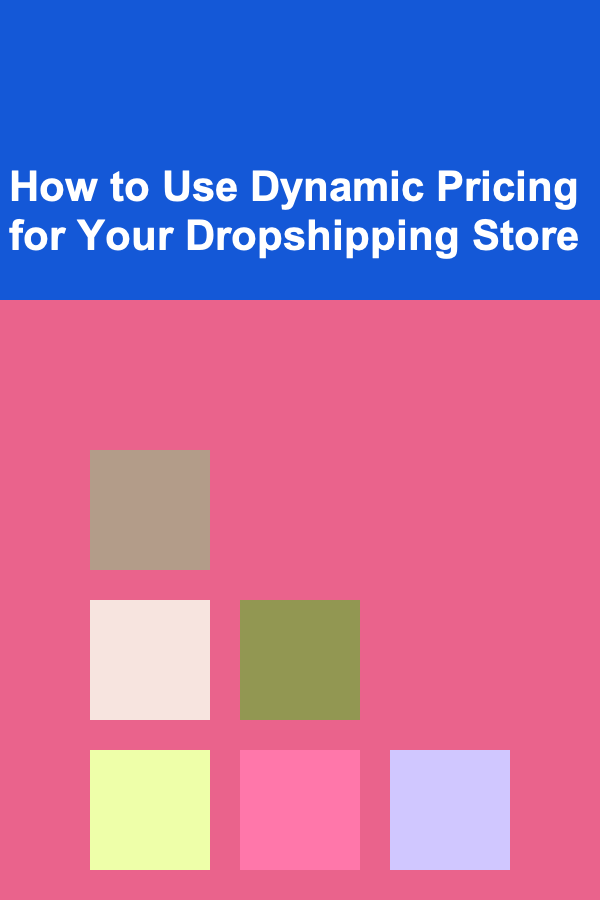
How to Use Dynamic Pricing for Your Dropshipping Store
ebook include PDF & Audio bundle (Micro Guide)
$12.99$7.99
Limited Time Offer! Order within the next:

Dynamic pricing is one of the most powerful strategies you can leverage to maximize profitability in your dropshipping store. By adjusting your product prices in real-time based on market conditions, demand fluctuations, and competitor pricing, you can ensure you're always offering the most competitive price while maximizing your margins. However, to implement dynamic pricing successfully, it's crucial to understand how it works and the strategies involved.
In this guide, we'll explore how dynamic pricing works, how it can benefit your dropshipping store, and practical steps you can take to implement it effectively.
What is Dynamic Pricing?
Dynamic pricing, often referred to as "surge pricing" or "real-time pricing," is the practice of continuously adjusting the price of a product based on various factors like demand, competition, supply, time of day, customer behavior, and even geographic location. Unlike fixed pricing, which remains static, dynamic pricing allows businesses to adapt to real-time conditions and optimize for profitability.
In the context of dropshipping, dynamic pricing allows you to adjust the price of products based on fluctuations in supplier costs, competitor pricing, demand, and market conditions. This approach ensures that you're always offering a price that balances competitiveness with profitability.
Why is Dynamic Pricing Important for Dropshipping?
Dynamic pricing can be an invaluable tool for dropshipping stores, offering several key benefits:
1. Maximizing Profit Margins
Dynamic pricing enables you to adjust prices based on demand and competition. For example, during high-demand seasons or when there's a product shortage, you can increase your prices slightly to boost your margins. Conversely, during slow periods, you can lower prices to stay competitive and attract customers.
2. Staying Competitive
In the world of eCommerce, competition is fierce. If you're using a static pricing model, you risk losing customers to competitors who are offering lower prices. Dynamic pricing helps you stay competitive by allowing you to adjust prices in response to competitor moves in real time.
3. Increasing Conversion Rates
By aligning your prices with current market trends and customer demand, dynamic pricing can help increase your conversion rates. Customers are more likely to make a purchase when they see that a product is priced competitively compared to others in the market.
4. Improving Inventory Management
Dynamic pricing can also help you manage your inventory more efficiently. When inventory levels are low, you can increase prices to maintain profitability and avoid running out of stock. On the other hand, if inventory is abundant, lowering the price can help clear out stock and move products faster.
Key Factors to Consider for Dynamic Pricing
When implementing dynamic pricing for your dropshipping store, there are several factors you need to consider to ensure your pricing strategy is effective.
1. Market Demand
The demand for your product can change due to several factors, such as seasonality, current trends, and economic conditions. When demand increases, you can raise your prices to take advantage of the higher willingness to pay. Conversely, when demand drops, lowering the price can help attract price-sensitive customers.
2. Competitor Pricing
The pricing strategies of your competitors play a crucial role in dynamic pricing. You need to monitor the prices set by other stores offering similar products. By staying aware of their pricing, you can adjust your prices in real time to maintain competitiveness.
3. Product Availability
In dropshipping, the availability of products from your suppliers can fluctuate. If a product becomes scarce or out of stock, you can increase the price to reflect the limited supply. However, make sure not to price gouge, as this can lead to customer dissatisfaction and potential reputational damage.
4. Customer Behavior
Understanding customer behavior is another critical factor. For example, you might find that customers are more likely to make a purchase during specific times of the day or in response to limited-time offers. Analyzing your store's customer data can provide valuable insights that you can use to optimize your pricing in real time.
5. Geographic Location
If you're selling internationally, pricing can also vary by location. Different regions may have different price sensitivities, purchasing power, and demand levels. Dynamic pricing can be used to adjust prices based on the geographic location of your customers.
How to Implement Dynamic Pricing for Your Dropshipping Store
Now that you understand the importance of dynamic pricing and the factors to consider, here's how you can implement it in your dropshipping store effectively.
1. Choose the Right Tools and Software
The foundation of any dynamic pricing strategy is automation. Manually adjusting prices for thousands of products is impractical, so you'll need to use pricing tools that can automate the process. There are several dynamic pricing tools designed for dropshipping stores that can help you adjust prices based on competitor analysis, supply changes, and customer behavior.
Some popular dynamic pricing tools for eCommerce include:
- Prisync: A dynamic pricing tool that tracks competitor pricing and automatically adjusts your prices to stay competitive.
- Informed.co: Formerly known as Appeagle, this tool offers automated pricing solutions, including rules-based pricing that adjusts based on competitor data.
- RepricerExpress: A pricing solution for Amazon and eBay sellers that automates price adjustments based on real-time competitor pricing and market conditions.
2. Set Clear Pricing Rules
While dynamic pricing tools automate much of the process, you still need to set clear rules for how your prices will change. For example, you can set the following rules:
- Price Adjustment for Competitors: If a competitor lowers their price by more than 5%, you can adjust your price to match or beat it.
- Price Increase Based on Demand: If sales of a specific product increase by 20% in a week, you can increase the price by a small percentage to capitalize on the demand.
- Minimum Price Threshold: Set a minimum price limit to ensure you never sell a product at a loss, even when adjusting for competition or demand.
- Seasonal Adjustments: Set rules to increase or decrease prices based on specific times of year, like holidays or promotional periods.
3. Monitor Competitors
Keeping an eye on your competitors is crucial for dynamic pricing. You should track the prices of competitors who sell similar products, especially if you're dropshipping from suppliers who may be offering the same items to other stores.
- Manual Monitoring: You can manually monitor competitor prices by regularly checking their websites or using tools like Google Shopping to compare prices.
- Automated Tools : Pricing tools like Prisync and Informed.co can automate competitor price tracking and automatically adjust your pricing accordingly.
4. Test and Optimize
Dynamic pricing is not a set-it-and-forget-it strategy. It's important to regularly test and optimize your pricing rules. Start by experimenting with different price points and rules to see how they affect your conversion rates, revenue, and profit margins.
You can run A/B tests to compare the performance of different pricing strategies and fine-tune them for optimal results. For instance, you could test how a 10% increase in price impacts sales volume or whether matching competitor prices leads to more conversions.
5. Communicate Transparency
While dynamic pricing allows you to adjust prices in real-time, it's essential to be transparent with your customers. Overpricing during periods of high demand can upset customers and harm your reputation. Always strive for a fair balance, and consider offering discounts or rewards during slow periods to retain customer loyalty.
Additionally, be cautious of the psychology of pricing. For example, psychological pricing, such as pricing products at $19.99 instead of $20.00, can encourage more purchases due to the perception of a bargain.
Conclusion
Dynamic pricing is a powerful strategy that can help your dropshipping store remain competitive, maximize profitability, and boost sales. By continuously adjusting your prices based on factors like market demand, competitor pricing, and customer behavior, you can ensure your products are priced optimally at all times.
To implement dynamic pricing successfully, you'll need to leverage the right tools, set clear pricing rules, monitor your competitors, and continuously test and optimize your strategy. With the right approach, dynamic pricing can take your dropshipping store to the next level and provide a significant edge in a highly competitive market.
Reading More From Our Other Websites
- [Organization Tip 101] How to Choose the Right Storage Solutions for Your Workspace
- [Personal Financial Planning 101] How to Identify and Avoid Financial Scams: Protecting Yourself from Fraud
- [Weaving Tip 101] A Beginner's Guide to Crochet-Infused Weaving Projects
- [Gardening 101] Top 10 Native Flowers That Attract Pollinators to Your Backyard
- [Stamp Making Tip 101] Love Stamped: Creative DIY Wedding Stamp Ideas for Your Big Day
- [Home Party Planning 101] How to Host Sophisticated Home Party Themes for Adults with a Wine Tasting Focus
- [Home Security 101] How to Protect Your Home with Glass Break Sensors: Tips for Installation and Use
- [Organization Tip 101] How to Utilize Wall Space for Storage
- [Personal Investment 101] Create Passive Income by Offering Deep Learning Services
- [Home Budget 101] How to Use Technology to Manage Your Home Budget Effectively

How to Create a Safe Room in Your Home
Read More
How to Host a Party with Limited Space in Your Home
Read More
How to Improve Your Home Security After a Recent Break-in
Read More
How to Keep Project Instructions and Ideas Organized
Read More
Why Clear Surfaces Lead to a More Peaceful Home
Read More
How to Aquascape a Dutch Style Aquarium: A Detailed Guide
Read MoreOther Products

How to Create a Safe Room in Your Home
Read More
How to Host a Party with Limited Space in Your Home
Read More
How to Improve Your Home Security After a Recent Break-in
Read More
How to Keep Project Instructions and Ideas Organized
Read More
Why Clear Surfaces Lead to a More Peaceful Home
Read More